Best Attractions to See in Lisbon: Culture, History, and More

Your Ultimate Guide to Lisbon’s Iconic Landmarks and Hidden Treasures
Lisbon, Portugal’s sun-drenched capital, enchants travelers with its pastel-colored streets, historic trams, and panoramic viewpoints. This captivating European destination offers an irresistible blend of ancient history, vibrant culture, and coastal Mediterranean charm that appeals to all types of travelers. From magnificent Moorish castles to contemporary art hubs, this comprehensive guide—part of our “Ultimate Guide to Traveling to Europe“, reveals the best attractions to see in Lisbon for an unforgettable Portuguese adventure.
Why Lisbon Stands Out Among European Capitals
Seven Hills Architecture: Lisbon is famously built across seven hills, creating a city of miradouros (viewpoints) that offer sweeping panoramic vistas of the glittering Tagus River and terracotta rooftops.

These natural elevations give the city its distinctive terrain and provide photographers with perfect composition opportunities at every turn.
Age of Maritime Discoveries: As the historic birthplace of legendary explorers like Vasco da Gama and Ferdinand Magellan, Lisbon celebrates its maritime heritage with impressive monuments and museums dedicated to Portugal’s golden age of global exploration.
The city’s strategic Atlantic location made it the launching point for voyages that changed world history.
Affordable European Luxury: Unlike its more expensive Western European counterparts, Lisbon offers world-class experiences, Michelin-starred dining, and boutique accommodations without breaking the bank.
This exceptional value makes it one of Europe’s most budget-friendly capital cities for luxury experiences.
Top 10 Must-See Attractions in Lisbon for Every Traveler
1. Belém Tower (Torre de Belém)
Why Visit: This UNESCO World Heritage Site stands as the definitive symbol of Portugal’s Age of Discoveries, built in 1515 as both a ceremonial gateway to Lisbon and a defensive fortress. Its strategic position and historical significance make it Lisbon’s most photographed landmark.

Key Features:
- Manueline Architecture: The tower showcases intricate stone carvings of nautical ropes, armillary spheres, and crosses, exemplifying Portugal’s unique Manueline architectural style that celebrates maritime achievements.
- Riverfront Location: Its position offers spectacular views of the Tagus River estuary and the nearby Monument to the Discoveries, creating perfect photo opportunities.
Insider Tip: Purchase tickets online (€8) to skip the notoriously long lines, especially during summer months. Complete your Belém experience with a visit to the nearby Pastéis de Belém bakery for their world-famous custard tarts (€1.20 each), made from a centuries-old secret recipe.
2. Jerónimos Monastery (Mosteiro dos Jerónimos)
Why Visit: This magnificent Gothic and Manueline masterpiece is where Vasco da Gama spent his last night in prayer before embarking on his historic voyage to India.
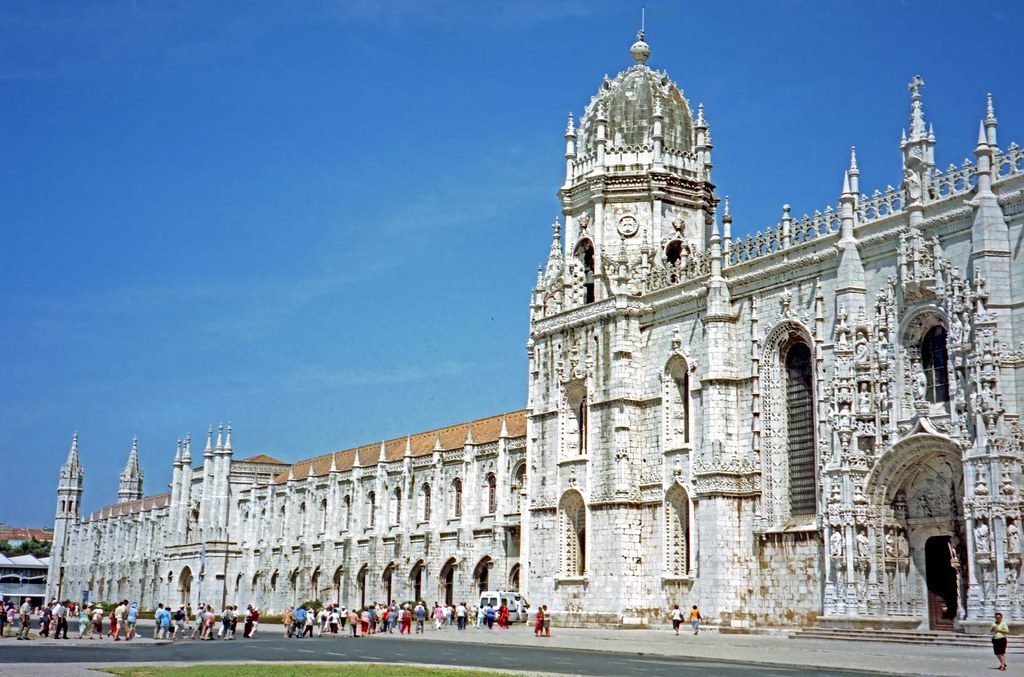
The monastery represents the pinnacle of Portugal’s architectural achievement during its wealthiest historical period.
Key Features:
- Spectacular Cloisters: The two-story cloisters feature ornate arches and elaborate maritime motifs throughout the South Wing, representing Portugal’s dominance of the seas.
- Tomb of Vasco da Gama: Located in the Santa Maria Church section, the explorer’s final resting place attracts history enthusiasts from around the world.
Insider Tip: Take advantage of free entry on the first Sunday of each month, but arrive early as lines form quickly. For a deeper understanding of the monastery’s historical significance, consider booking a guided historical tour of Belém that includes both the monastery and nearby attractions.
3. Alfama District – Lisbon’s Historic Soul
Why Visit: As Lisbon’s oldest and most authentic neighborhood, Alfama survived the devastating 1755 earthquake that destroyed much of the city.
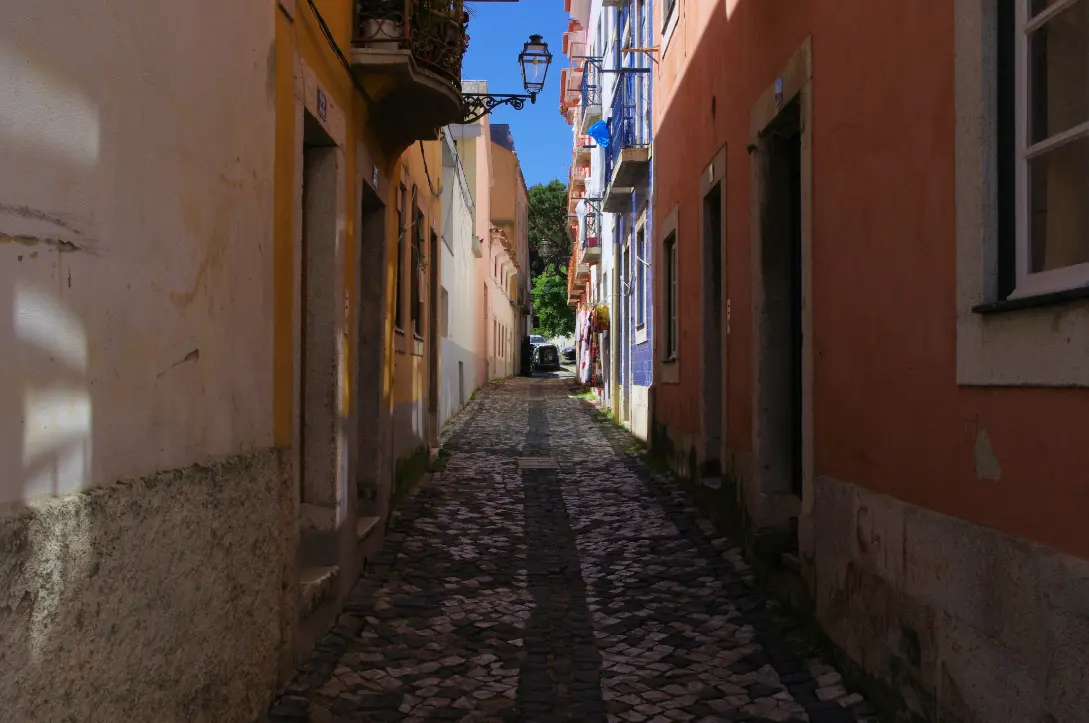
Its labyrinthine maze of narrow cobblestone streets, traditional taverns, and melancholic Fado music venues offers the most immersive cultural experience in Lisbon.
Key Features:
- Miradouro de Santa Luzia: This charming tiled terrace provides breathtaking river views and photo opportunities framed by bougainvillea-covered pergolas.
- Authentic Fado Performances: Experience Portugal’s soulful traditional music at intimate venues like Clube de Fado, where €25 covers both a traditional Portuguese dinner and world-class performance.
Insider Tip: Experience Alfama like a local by riding the iconic Tram 28 through its steep, winding streets for a nostalgic journey (€3 single ticket). For the best experience, explore the district early in the morning when residents go about their daily routines and before tourist crowds arrive.
4. São Jorge Castle (Castelo de São Jorge)
Why Visit: Perched atop Lisbon’s highest hill, this Moorish fortress offers unparalleled 360° views of Lisbon’s distinctive red rooftops and winding streets.
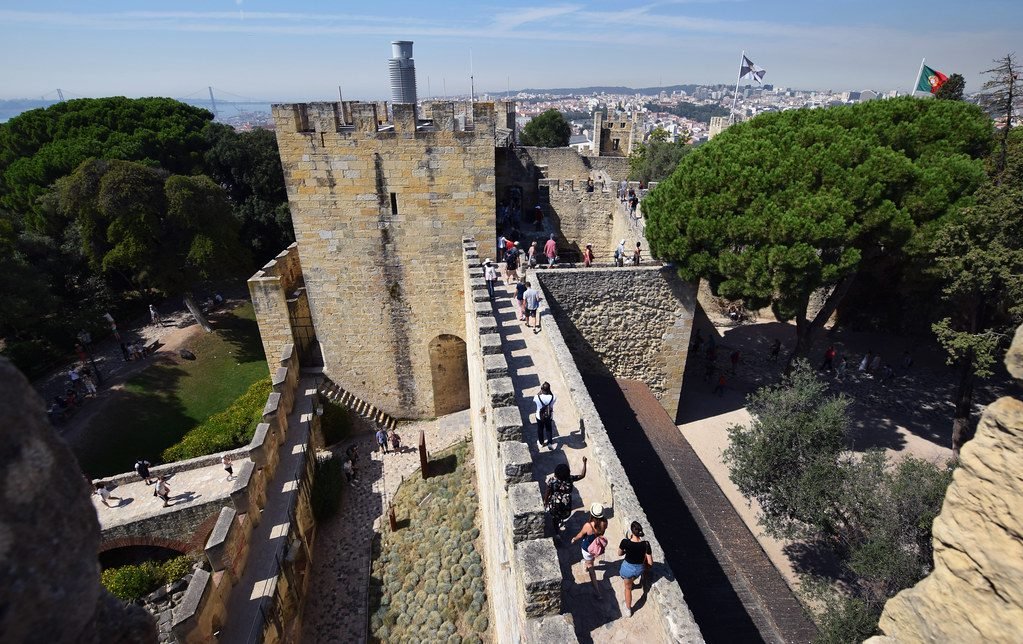
Dating back to the 11th century, the castle provides crucial insights into Lisbon’s multicultural past and Moorish influence.
Key Features:
- Extensive Archaeological Site: Explore Iron Age ruins, Roman remains, and a fascinating medieval cistern that reveals Lisbon’s layered history.
- Castle Gardens: Wander through peaceful gardens where peacocks roam freely among ancient olive trees, creating a surreal experience in the heart of the city.
Insider Tip: Plan your visit for sunset (€15 entry) to capture golden-hour photography of Lisbon bathed in warm light. The Camera Obscura periscope in the Tower of Ulysses offers a unique 360° real-time view of the city worth experiencing.
5. Tram 28 – Lisbon’s Moving Monument
Why Visit: More than just public transportation, the vintage yellow Tram 28 has become an attraction itself, winding through Lisbon’s steepest hills and most historic districts.
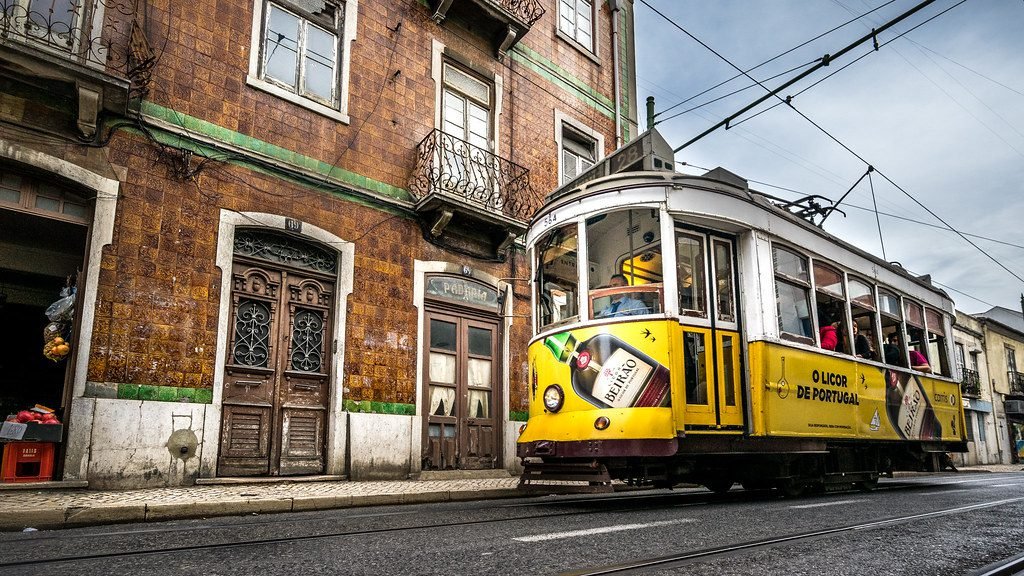
This nostalgic journey offers an authentic glimpse into local life while connecting major attractions.
Route: The complete journey stretches from Martim Moniz to Campo Ourique, passing through picturesque Graça, historic Alfama, downtown Baixa, and elegant Chiado districts along the way.
Insider Tip: Board at the Martim Moniz terminus between 7–8 AM to secure a seat and avoid the tourist crowds. Purchase the Lisboa Card for unlimited free rides along with discounted attraction entries. For a less crowded alternative with similar views, consider Tram 24 or 25.
6. LX Factory – Lisbon’s Creative Heart
Why Visit: This revitalized industrial complex under the 25 de Abril Bridge has transformed into Lisbon’s hippest creative hub, housing design studios, art galleries, and innovative restaurants.
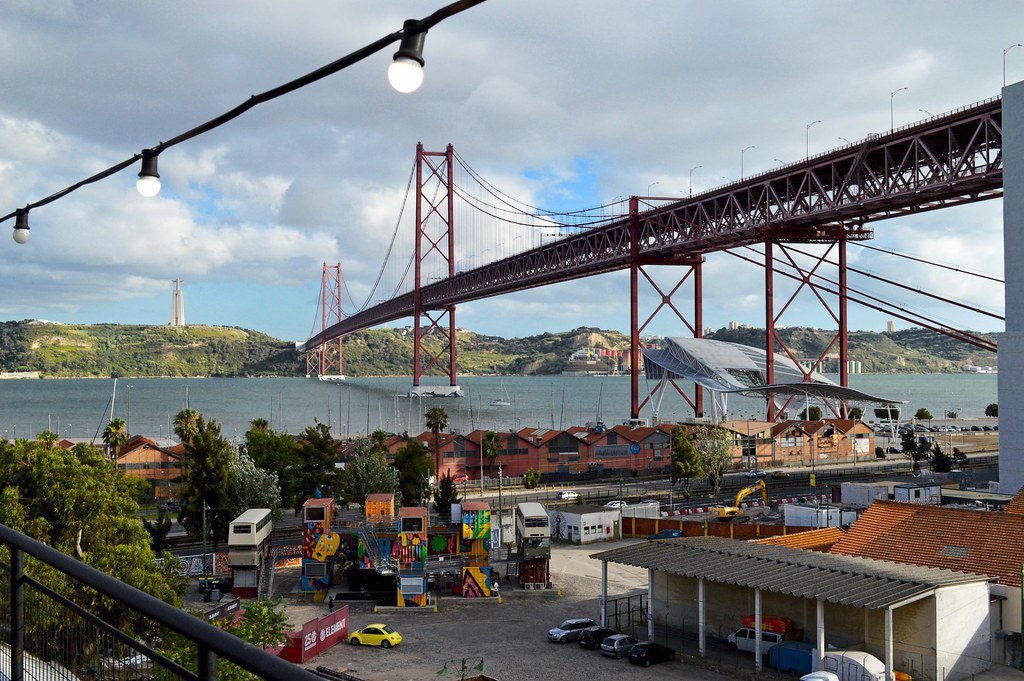
The space represents Lisbon’s perfect balance between preserving history and embracing modernity.
Key Features:
- Ler Devagar Bookstore: This Instagram-famous two-story literary paradise features suspended vintage bicycles, flying books, and a café where Lisbon’s creative community gathers.
- Sunday LX Market: Browse local crafts, vintage vinyl records, artisanal foods, and unique souvenirs in this weekly gathering of Lisbon’s artistic entrepreneurs.
Insider Tip: Cap your visit with dinner at Rio Maravilha for innovative fusion cuisine, craft cocktails, and rooftop views of the 25 de Abril Bridge. Visit on weekday afternoons when the area is less crowded but all businesses remain open.
7. Bairro Alto – Where Lisbon Comes Alive
Why Visit: Functioning as Lisbon’s nightlife epicenter after dark and a quirky arts district by day, Bairro Alto encapsulates the city’s dual personality.
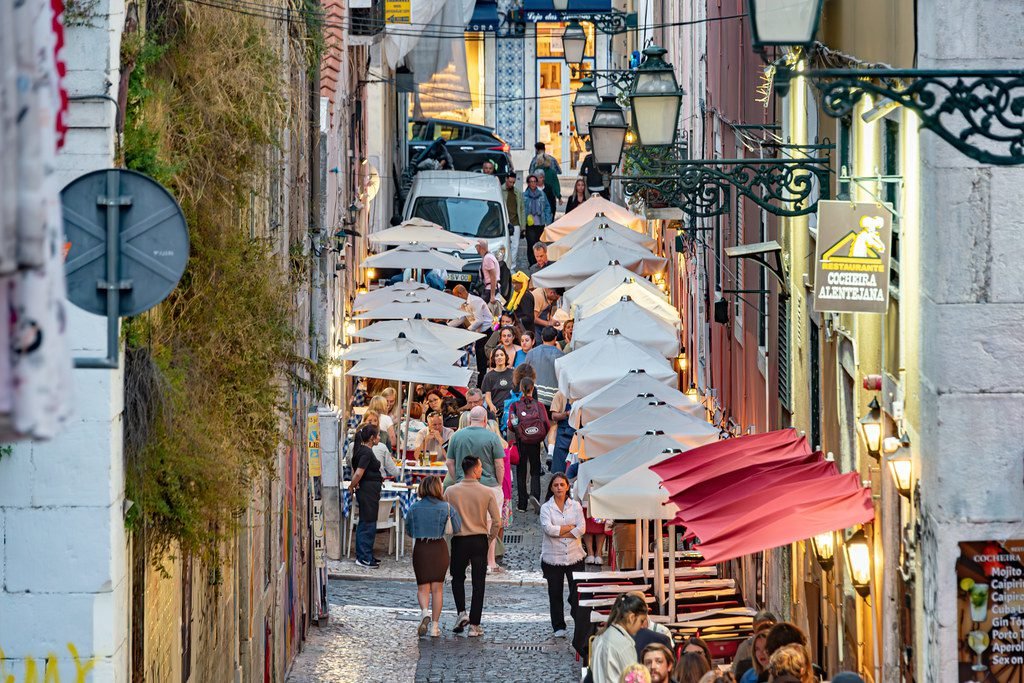
Its elevated position provides excellent views while its narrow streets hide countless bars, restaurants, and boutiques.
Key Features:
- Cutting-Edge Street Art: Discover impressive murals by renowned Portuguese artists like Vhils and Bordalo II, whose distinctive techniques have gained international recognition.
- Pink Street (Rua Nova do Carvalho): Once Lisbon’s red-light district, this neon-lit pedestrian area now houses trendy bars and acclaimed music venues like MusicBox.
Insider Tip: While most visitors experience Bairro Alto at night, daytime visits reveal charming boutique shops like A Vida Portuguesa for authentic Portuguese souvenirs and products.
For the best experience, visit between 5-7 PM when shops are still open and bars begin to come alive.
8. Praça do Comércio – Lisbon’s Majestic Gateway
Why Visit: This grand riverside square, completely rebuilt after the catastrophic 1755 earthquake, serves as Lisbon’s ceremonial entrance from the Tagus River.

Its elegant yellow buildings and triumphal arch represent the city’s resilience and rebirth.
Key Features:
- Arco da Rua Augusta: Climb to the top of this triumphal arch for panoramic views of the square, river, and downtown Lisbon (€3.50).
- Impressive Statue of King José I: Admire this bronze equestrian monument at the square’s center, created by the renowned sculptor Machado de Castro.
Insider Tip: Experience a taste of literary Lisbon at Café Martinho da Arcada, Portugal’s oldest café and a favorite haunt of legendary Portuguese poet Fernando Pessoa. The square is also spectacular when illuminated at night, offering excellent long-exposure photography opportunities.
9. Time Out Market – Culinary Excellence Under One Roof
Why Visit: This innovative gourmet food hall showcases Portugal’s finest culinary talents, bringing together Michelin-starred chefs and traditional food artisans under one historic market roof.

It offers the perfect introduction to Portuguese gastronomy in a lively atmosphere.
Must-Try Culinary Experiences:
- Marisqueira Azul: Savor perfectly prepared garlic shrimp (€14) from one of Lisbon’s most respected seafood specialists.
- Santini: Sample their legendary passionfruit gelato (€3.50), considered by many to be Portugal’s finest ice cream since 1949.
Insider Tip: The market gets extremely busy during peak meal times, so arrive by 11:30 AM to secure a good spot at the communal tables. Visit the traditional Mercado da Ribeira side of the building first to see local vendors selling fresh Portuguese ingredients.
10. Day Trip to Sintra – Fairytale Escape Near Lisbon
Why Visit: Located just 40 minutes from Lisbon by train, this UNESCO-listed town transports visitors to a romantic fairytale setting with its microclimate, lush forests, and extravagant palaces.

Sintra represents the perfect contrast to urban Lisbon.
Key Features:
- Pena Palace: This rainbow-colored Romanticist castle (€14 entry) perched dramatically atop a forested peak embodies 19th-century Romantic ideals and Portuguese architectural eclecticism.
- Quinta da Regaleira: Explore mystical gardens with symbolic initiation wells, secret tunnels, and Gothic towers (€10 entry) that reflect their creator’s fascination with alchemy and mysticism.
Insider Tip: Rather than attempting to see all of Sintra’s attractions in one day, focus on two major sites and avoid weekend crowds.
Take the Scotturb Bus 434 loop service to navigate between sites and avoid the challenging uphill hikes on narrow roads.
Practical Tips for Visiting Lisbon Effectively

Lisboa Card Value: Invest in this city pass (€21/24 hours) to save significantly on transport and major attractions while avoiding ticket lines.
Efficient Transportation: Download the Carris app for real-time tram and bus updates to minimize waiting times.
Safety Awareness: Exercise caution regarding pickpockets in crowded tourist areas like Tram 28 and Baixa district.
Optimal Travel Seasons: Visit during shoulder seasons (March–May or September–October) for ideal mild weather and fewer crowds.
Appropriate Footwear: Pack sturdy, comfortable shoes—Lisbon’s steep hills and uneven cobblestone streets demand proper walking gear!
Sample 3-Day Lisbon Itinerary for First-Time Visitors
Day 1: Exploring Belém’s Maritime Heritage
- Morning: Visit Belém Tower and Jerónimos Monastery to understand Portugal’s Age of Discoveries.
- Afternoon: Enjoy the famous pastries at Pastéis de Belém followed by contemporary art at the MAAT Museum.
- Evening: Catch a magical sunset at Miradouro da Senhora do Monte viewpoint, followed by dinner in nearby Graça.
Day 2: Discovering Historic Lisbon
- Morning: Wander through the atmospheric Alfama District before crowds arrive and explore São Jorge Castle.
- Afternoon: Experience a complete Tram 28 ride followed by lunch at Time Out Market.
- Evening: Immerse yourself in an authentic Fado dinner experience in Alfama or Mouraria.
Day 3: Venturing Beyond Lisbon
- Day Trip: Spend a full day exploring Sintra’s magical Pena Palace and mystical Quinta da Regaleira.
- Evening: Return to Lisbon for farewell drinks at Park Rooftop Bar, cleverly hidden atop a nondescript parking garage in Bairro Alto.
Final Thoughts on Lisbon’s Timeless Appeal
Lisbon masterfully blends old-world Portuguese charm with contemporary creative energy, offering visitors an authentic European experience without the overwhelming crowds or prices of other major capitals.
Its unique combination of Mediterranean climate, Atlantic influences, and centuries of cultural fusion creates a destination unlike any other in Europe.
For more comprehensive European travel guidance, explore companion pieces like “Best Attractions in Barcelona” for a complete Iberian Peninsula experience.
Boa viagem! 🌞🇵🇹
Frequently Asked Questions: Visiting Lisbon’s Attractions
What is the best time of year to visit Lisbon’s attractions?
The ideal time to visit Lisbon is during the spring (April-June) or fall (September-October) when temperatures are pleasant (65-75°F/18-24°C), tourist crowds are thinner, and prices are lower than peak summer.
Summer months (July-August) offer reliable sunshine but can be very hot and crowded. Winter remains mild (50-60°F/10-15°C) and offers the benefit of almost no lines at major attractions, though some coastal sites may have reduced hours.
Is there a city pass that covers multiple Lisbon attractions?
Yes, the Lisboa Card is an excellent investment for visitors planning to see multiple attractions.
Available in 24, 48, and 72-hour options, it includes free entry to 35+ museums and monuments (including Torre de Belém and Jerónimos Monastery), free unlimited public transportation, and discounts on many other attractions and services.
The card can be purchased online or at tourism offices throughout the city.
How accessible are Lisbon’s major attractions for visitors with mobility challenges?
Lisbon’s hilly terrain and historic cobblestone streets present challenges for visitors with mobility issues. However, many major attractions have made accessibility improvements.
Belém’s monuments are mostly accessible, and modern museums like MAAT offer full accessibility. The historic neighborhoods of Alfama and Bairro Alto remain challenging with steep streets and limited elevator access.
Call attractions in advance to inquire about specific accommodations, and consider using the accessible public transportation options (newer metro stations and some trams are equipped for wheelchair users).
What are the “must-try” local foods near Lisbon’s top attractions?
Look for these authentic Portuguese specialties while exploring Lisbon:
- Pastéis de Belém (custard tarts) at the famous bakery near Jerónimos Monastery
- Bacalhau (salted cod) dishes in traditional restaurants around Alfama
- Ginjinha (sour cherry liqueur) from tiny shops near Rossio Square
- Fresh seafood, especially sardines and octopus, at waterfront restaurants in Cais do Sodré
- Alheira (traditional Portuguese sausage) and regional cheeses at Time Out Market
Is it better to explore Lisbon’s attractions independently or with a guided tour?
Both approaches have merits depending on your travel style. Independent exploration allows flexibility and is easy with Lisbon’s generally good public transportation.
However, guided tours provide valuable historical context and cultural insights that greatly enhance sites like Alfama, São Jorge Castle, and Belém’s monuments. Consider a compromise: start with a walking tour on your first day to orient yourself and learn the basics, then explore specific attractions independently afterward.
For areas like Sintra, guided tours can save time navigating between the widespread palaces and gardens.




